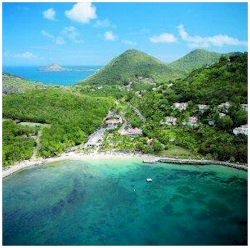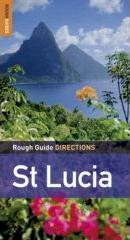 DISCOVER ST. LUCIA
DISCOVER ST. LUCIA
Saint Lucia is an island nation in the eastern Caribbean Sea on the boundary with the Atlantic Ocean. Part of the Lesser Antilles, it is located north of the islands of Saint Vincent and the Grenadines, northwest of Barbados and south of Martinique. It is also known as the "Helen of the West Indies" because it switched between British and French control so often it was likened to the mythical Helen of Troy.
 Saint Lucia is one of the Windward Islands, named for Saint Lucy of Syracuse. It was first visited by Europeans in about the year 1500 and first colonized successfully by France who signed a treaty with the native Carib peoples in 1660. Great Britain took control of the island from 1663 to 1667 then went to war with France over it fourteen times, and finally took complete control in 1814.
Saint Lucia is one of the Windward Islands, named for Saint Lucy of Syracuse. It was first visited by Europeans in about the year 1500 and first colonized successfully by France who signed a treaty with the native Carib peoples in 1660. Great Britain took control of the island from 1663 to 1667 then went to war with France over it fourteen times, and finally took complete control in 1814.
Representative government came about in 1924 (with universal adult suffrage from 1953) and from 1958 to 1962 the island was a member of the Federation of the West Indies.
Finally, on February 22, 1979, Saint Lucia became an independent state of the Commonwealth of Nations. The island nation celebrates this every year with a public holiday.
Saint Lucia is divided into 11 quarters - Anse la Raye, Canaries, Castries, Choiseul, Dennery, Forest, Gros Islet, Laborie, Micoud, Soufrière, and Vieux Fort.
 GEOGRAPHY OF ST. LUCIA GEOGRAPHY OF ST. LUCIA
The volcanic island of Saint Lucia is more mountainous than many other Caribbean islands, with the highest point being Mount Gimie, at 950 metres (3,120 ft) above sea level. Two other mountains, the Pitons, form the island's most famous landmark. They are located between Soufrière and Choiseul on the western side of the island. Saint Lucia is also one of the few islands in the world that boasts a drive-in volcano.
The capital city of Saint Lucia is Castries, where about one third of the population lives. Major towns include Gros Islet, Soufrière and Vieux Fort. The local climate is tropical, moderated by northeast trade winds, with a dry season from January to April and a rainy season from May to December.
 CULTURE OF ST. LUCIA CULTURE OF ST. LUCIA
The culture of Saint Lucia has been influenced by African, French and English heritage. One of the secondary languages is Kreole, a form of French patois.
Festivals
Saint Lucian cultural festivals include La Rose and La Marguerite, the one representing the Rosicrucian order, the other one representing Freemasonry.
Traditionally, in common with other Caribbean countries, Saint Lucia held a carnival before Lent. In 1999, it was moved to mid-July in order to coincide with the much larger Trinidad and Tobago carnival, so as to attract more overseas visitors.
As well as other Caribbean music genres such as soca, zouk, kompa, and reggae, Saint Lucia has a strong indigenous folk music tradition. A popular folk dance is the Quadrille.
Each May since 1992, Saint Lucia has hosted an internationally-renowned Jazz Festival.
 TOURISM TOURISM
Tourism is vital to St. Lucia's economy and the economic importance of such is expected to continue to increase as the market for bananas becomes more competitive. Tourism tends to be more substantial during the dry season (January to April). St Lucia tends to be popular due to its tropical weather and scenery and its large number of beaches and resorts.
Other tourist attractions include the world's only drive-in volcano, Sulfur Springs (at Soufrière), the Botanical Gardens, the rain forests and Pigeon Island National Park, which is home to Fort Rodney, an old British military base.
The majority of tourists visit St. Lucia as part of a cruise. Most of their time tends to be spent in Castries, although Soufrière, Marigot Bay and Gros Islet are popular locations to visit. Tourists should venture from the beaten path of shops and beaches and explore the beautiful nature of St. Lucia. George Foreman, the famous boxer and entrepreneur, owns a home in Marigot Bay.
From Wikipedia.org, the Free Encyclopedia
 ST. LUCIA HOTELS & RESORTS ST. LUCIA HOTELS & RESORTS
 ST. LUCIA TOURS & TRAVEL ST. LUCIA TOURS & TRAVEL

HOME •
CARIBBEAN •
DISCOVER •
ST. LUCIA •
Discover St. Lucia
|
|
Looking for something specific?
|
 
|




 DISCOVER ST. LUCIA
DISCOVER ST. LUCIA Saint Lucia is one of the Windward Islands, named for Saint Lucy of
Saint Lucia is one of the Windward Islands, named for Saint Lucy of 

